20 July, 2001
Friday
Today was one of those days packed with things to do from 9 am to 11 this
evening. We started retaking growth measurements in Glen's plots. Three
weeks ago we took the initial measurements and marked the individual
plants and grasses. Today, we relocated the grasses and vascular plants
and measured them a second time to get growth data. With 4 people doing
this we thought it would be completed faster than the first go-round but
the plots have filled in and grown so much that locating the originals
took more time than we first thought. They will continue this till
finished which might be in 2 or 3 days.
This morning, while we were on our stomachs counting, we battled
mosquitoes and this afternoon the breeze kicked up and got rid of the
pesty insects only to bring us rain clouds from inland, we ended up
soaked. The upside was the storm left a rainbow behind so it was worth
it. This is the nice thing about working in the field; you never know
what will happen during the day!
The plots were a surprise to "weed" through. The vegetation had grown
thicker in the heated plots and the plots with more water but the real
surprise to me was how fast everything has grown. With a short growing
season the grasses and vascular plants take off quickly, develop
inflorescence maturing in 3 to 5 weeks. The constant sunlight and
comparatively warm temperatures, along with the moisture from the melted
snow, all add to speeding up the growth rates in the arctic.
After counting and measuring plants all day 4 of us, Joe, Michelle, Steve
and myself went out on the boat of a local Inupiat hunter Walter. We all
hopped into the boat at about 6 pm with Walter, a friend of his and
Walter's two younger children. They are hunting seal or walrus at this
time of year so to find them you have to go to where the ice is, about 15
to 20 miles out. With a 250 motor it got us where we wanted to be fairly
quickly. We reached the ice and the temperature dropped. The ice was
pretty broken up since we went south where the walrus have been spotted.
The local people hunt with guns and harpoons. They are constantly on the
lookout for seals or walrus popping their head above water or laying on
the ice flows. They spotted a walrus and we snapped pictures frantically.
Walter had his gun ready but the walrus dove and managed to get away. The
Inupiats will use the tusks for carving and the meat for eating. Walter
has caught a number of walrus this summer. When that occurs and the
hunters' families cannot store or use the meat they will give it to the
elders of the village as a sign of respect. The culture stresses sharing
and taking care of everyone and in this way keeps the community ties
strong.
On the return Walter spotted a bearded seal, much prized for its meat and
especially its skin. This is used to cover the sealskin boats, umiaks,
which are used in the traditional spring whale hunt. The whaling crews
have to recover the wooden frame every one to two years depending on the
condition they are left in after the hunt. It takes approximately 8 skins
to cover an umiak, which is sewn together by the women in the village.
Sewing is important and requires much skill in that all seems have to be
waterproof.

Off to the sites this morning. The fog cleared up about an hour later. Glen, Steve, Stan and Erika. Lety any I are in the back.
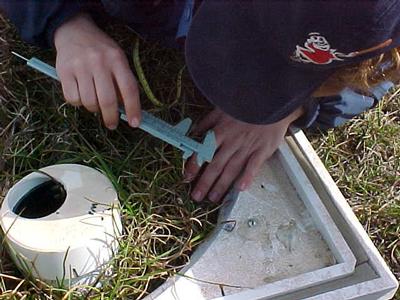
Michelle measuring the specific, individual plants in one of the plots. Not all the plants had to be remeasured only a sample of each species whose locations were recorded and marked.
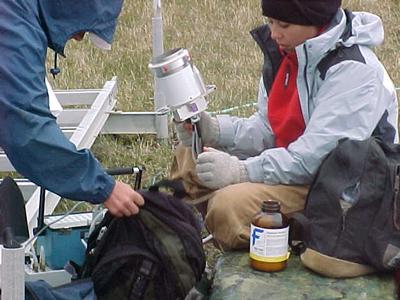
Lety is changing the desiccant on the LiCor. The desiccant absorbs the moisture (H2O vapor) that is in the air, which passes through the instrument. All the instruments have to be taken care of . It is part of doing good science.
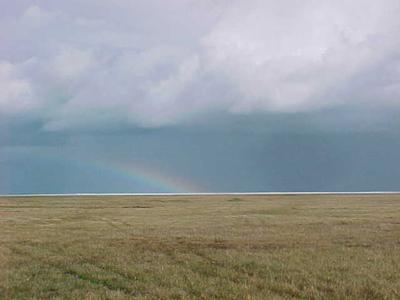
The end of every trip (or slide show) ends with a perfect sunset picture. I had to take the next best thing since the sun will not set for weeks yet!

Joe and Michelle on the boat...we were "hunting" pictures.
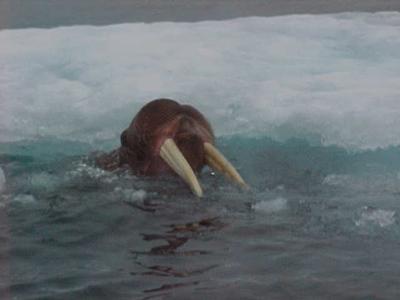
The walrus which we saw out on the ice. They are large, social creatures which are on the ice flows this time of year
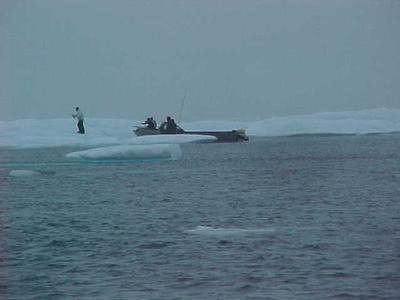
Two other boats we passed about 20 miles out in the ice.
Contact the TEA in the field at
.
If you cannot connect through your browser, copy the
TEA's e-mail address in the "To:" line of
your favorite e-mail package.
|
